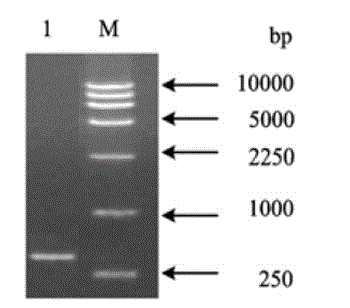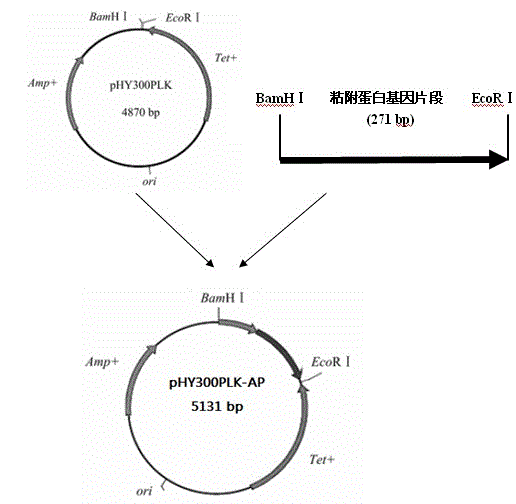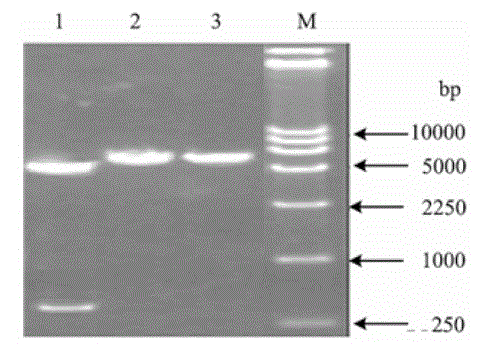High adhesion clostridium butyricum and its preparation method
A technology of Clostridium butyricum and high adhesion, which is applied in the fields of botany equipment and methods, biochemical equipment and methods, chemical instruments and methods, etc., and can solve problems such as low adhesion performance, colonization, and affecting application effects
- Summary
- Abstract
- Description
- Claims
- Application Information
AI Technical Summary
Problems solved by technology
Method used
Image
Examples
Embodiment 1
[0034] Example 1 Cloning of Lactobacillus Adhesin Gene Sequence
[0035] According to literature records (Complete genome sequence of Lactobacillus kefiranofaciens ZW3. Journal of Bacteriology, 2011, 193(16): 4280-4281) and NCBI (National Center for Biotechnology Information) (GeneBank accession number: NC_015602) recorded lactobacillus adhesion protein gene sequence, and according to Bacillus subtilis The multiple cloning restriction site of plasmid pHY300PLK, design gene-specific primers carrying the corresponding restriction site to amplify the target gene (Lactobacillus Adhesin gene) for the construction of recombinant expression vector.
[0036] The primers used are: 5'-CGC GGATCC ATGAATACTGTTGCTCCTC-3' (as an upstream primer, carrying B amHI restriction site) and 5'-CCG GAATTC ATTTTTTTTACGTTTTTTTT-3' (as a downstream primer, carrying E coRI restriction site, the protection bases are CGC and CCG respectively).
[0037] from Lactobacillus kefir ( Lactobacillus k...
Embodiment 2
[0042] Example 2 Construction of recombinant plasmid pHY300PLK-AP
[0043] After separation by electrophoresis, the PCR product (relative molecular weight: 271bp) of the target gene was recovered (SK8131, SanPrep Column DNA Gel Recovery Kit, Shanghai Sangong Bioengineering Company), and an appropriate amount of the recovered product was mixed with Bacillus subtilis plasmid pHY300PLK (purchased In China Plasmid Vector Strain Cell Strain Gene Collection Center) were digested with restriction endonucleases BamHI and EcoRI (restriction endonucleases were purchased from Shanghai Sangon Bioengineering Co., Ltd.), and then ligated with T4 DNA ligase (vector The build process is attached figure 2 ), transformed into DH5α, screened on the LB plate containing ampicillin and tetracycline double antibody to obtain a single clone, shake the bacteria to expand culture, and extract the plasmid. B amHI and E coRI double enzyme digestion verification (see image 3 ) and sent to Shanghai Sa...
Embodiment 3
[0044] Example 3 Transformation of Clostridium butyricum
[0045] Take the Clostridium butyricum cultured to the exponential growth phase (cultured for about 16 hours, Clostridium butyricum was isolated and preserved by our laboratory) to prepare competent cells, add the plasmid pHY300PLK-AP, mix well, and then transform the cells by electric shock , the transformed cells were cultured at 37°C, and after 1.5 hours, coated with tetracycline-containing LB medium plate, followed by anaerobic culture at 37°C for 24 hours, colony PCR was performed, and positive clones were obtained by electrophoresis detection, and false positive clones that were not successfully transformed were excluded. Positive clones were transformed Clostridium butyricum.
PUM
 Login to View More
Login to View More Abstract
Description
Claims
Application Information
 Login to View More
Login to View More - R&D
- Intellectual Property
- Life Sciences
- Materials
- Tech Scout
- Unparalleled Data Quality
- Higher Quality Content
- 60% Fewer Hallucinations
Browse by: Latest US Patents, China's latest patents, Technical Efficacy Thesaurus, Application Domain, Technology Topic, Popular Technical Reports.
© 2025 PatSnap. All rights reserved.Legal|Privacy policy|Modern Slavery Act Transparency Statement|Sitemap|About US| Contact US: help@patsnap.com



